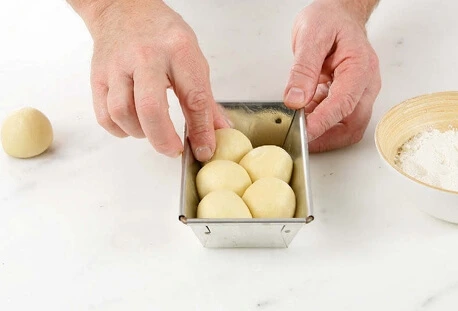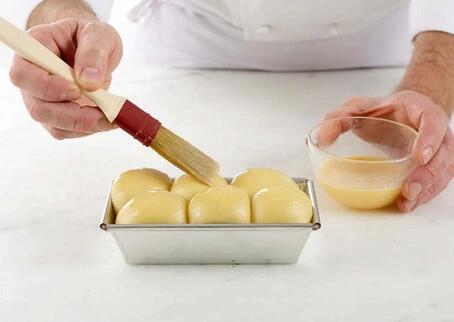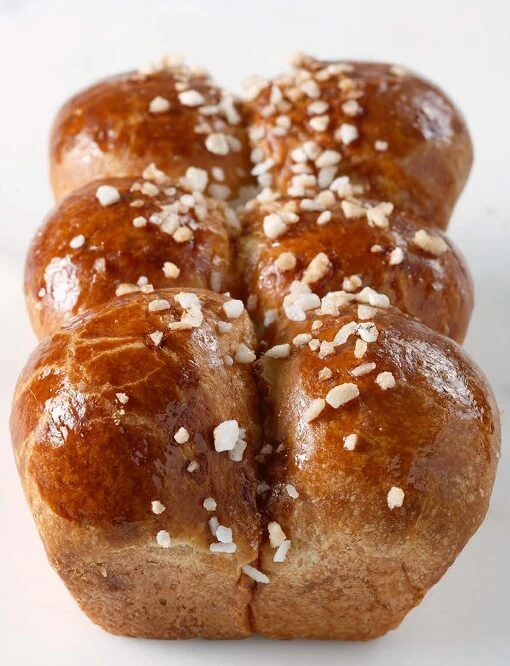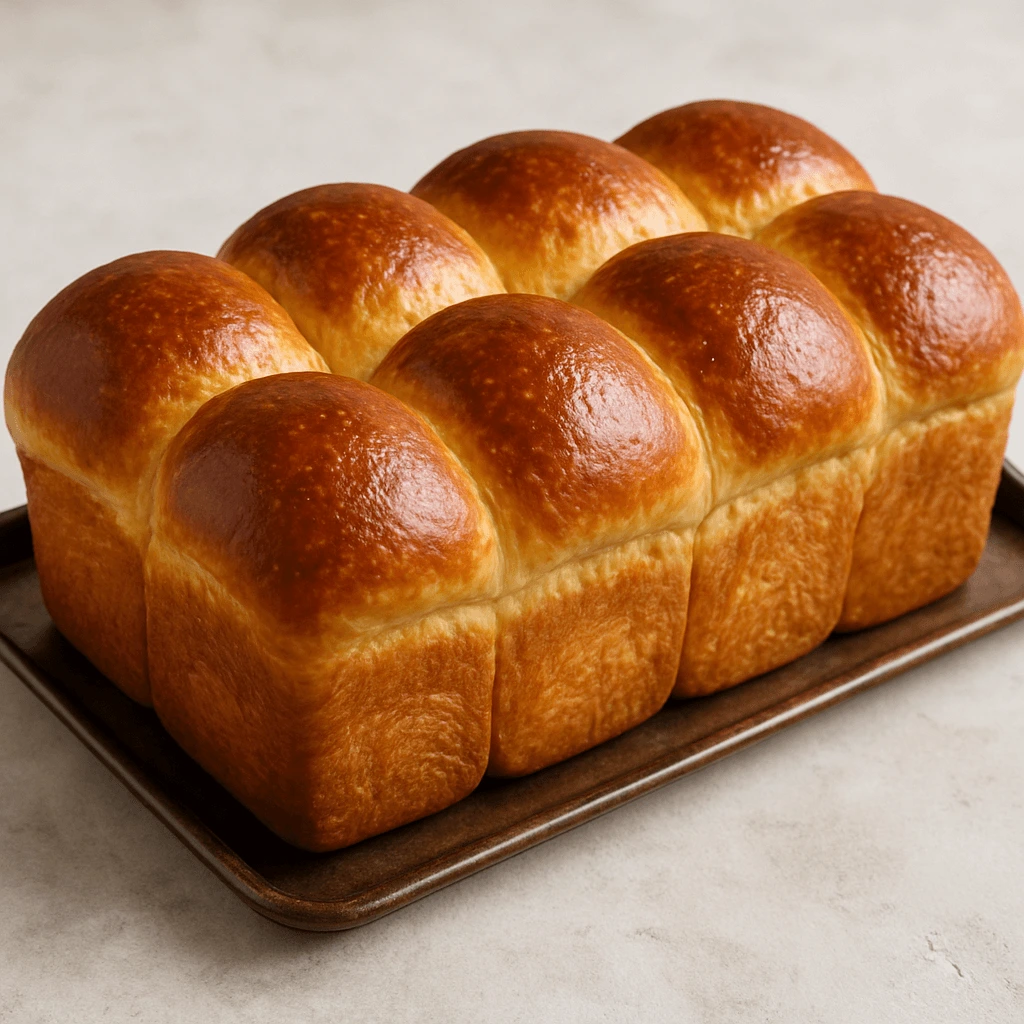Perfect Brioche
Golden, airy, and subtly rich—the Brioche Nanterre is a quiet triumph of French baking. Unlike its more flamboyant cousins, it makes no loud declarations. Its beauty lies in its structure: a series of smooth, rounded domes nestled tightly in a rectangular mold, rising together to form a loaf that’s both sculptural and indulgent. It’s the kind of pastry that whispers of precision, patience, and restraint.
This traditional brioche is baked in a loaf tin, distinguishing it from braided versions or individual buns. Its crumb is exceptionally light, delicately enriched with butter, and its crust, a deep honeyed brown, gives way to a feathery interior. When pulled apart, each piece offers a gentle resistance, stretching just slightly before melting in the mouth.
Making a Brioche Nanterre is as much about technique as it is about time. The dough must be developed slowly, often over two days, with long fermentations that reward the baker with complexity of flavor and unmatched texture. It’s a ritual that respects the process as much as the result.
Served with jam, a touch of honey, or enjoyed plain, it’s perfect at breakfast, for a refined goûter, or as a base for more elaborate creations like French toast or bread pudding. But in its purest form, the Nanterre needs no embellishment. Its elegance is self-contained—just enough sweetness, just enough richness, and a lot of care.Brioche explained on Wikipedia
Timeline – For 6 Servings
- Preparation time: 45 minutes
- First proof (bulk fermentation): 30 minutes
- Refrigeration (resting the dough): At least 2 hours
- Final proof (before baking): 1 hour 30 minutes to 2 hours
- Baking time: 25 minutes
- Storage: Keeps for up to 48 hours at room temperature, well wrapped
Recipe for 300 g of Brioche Dough
Time:
- Preparation: 30 minutes
- First proof (bulk fermentation): 30 minutes
- Refrigeration: At least 2 hours
- Baking: 170°C to 220°C (depending on the size of the pieces)
- Storage: Up to 48 hours in the refrigerator
Equipment:
- Stand mixer
- Dough scraper
Ingredients:
- 125 g bread flour (or T45/T55 high-gluten flour)
- 62.5 g eggs (about 1 whole egg plus a little extra)
- 12.5 g whole milk
- 12.5 g sugar
- 2.5 g fine salt
- 4 g fresh baker’s yeast
- 25 g crème fraîche (or heavy cream)
- 60 g softened butter
Finishing Touches
Egg Wash (Dore):
- 25 g whole egg
- 20 g egg yolk
- 25 g whole milk
→ Mix well to create a smooth egg wash for a glossy golden crust.
Optional Topping:
- Pearl sugar (as needed)
Equipment:
- Stand mixer
- Bench scraper
- Pastry brush
- Dough scraper
- Brioche Nanterre mold or loaf pan (approx. 20 cm × 10 cm × 6 cm)
Shaping & Baking Instructions
- Divide the dough into six equal portions and shape each into a smooth ball. Arrange them in a staggered (zigzag) formation inside a well-buttered loaf pan.
- Brush the tops with the prepared egg wash. Then, allow the dough to proof in a warm, humid environment—either in a proofing box or in an oven that’s turned off with a bowl of steaming water inside—for 1 hour 30 minutes to 2 hours at around 26 °C (78.8 °F).

- Once fully risen, brush with egg wash a second time. Bake in a preheated oven at 175 °C (347 °F) for about 25 minutes, until golden and well-risen.
- If desired, sprinkle pearl sugar over the top before baking for a decorative finish.

- Unmold the brioche immediately after baking to allow steam to escape and the crust to set properly.

CHEF’S TIPS
- You can also line the mold with parchment paper.
- The rising time before baking can vary; the dough should double in size.
Conclusion:
In conclusion, mastering the art of brioche is a rewarding journey for any baker. Whether you’re new to the world of brioche or you’re looking to perfect your technique, the process can be both exciting and deeply satisfying. The golden, buttery texture and the light, fluffy crumb are the hallmarks of a successful brioche. Remember, the key to achieving the best brioche lies in patience—giving your dough the right amount of time to rise and using quality ingredients. With the right tools and a bit of practice, you’ll soon be able to enjoy a perfectly braided, tender brioche fresh from the oven.
Baking brioche is as much about understanding the dough as it is about enjoying the process. Once you’ve mastered the basics, feel free to experiment with different fillings or shapes, and make it your own! Brioche is versatile enough to be adapted for a wide range of recipes, from savory to sweet, making it a staple that can bring joy in any season.moor recipe: How to Shape the Perfect Brioche à Tête
Questions and Answers:
Q: Why does the dough need to rest for so long before baking? A: Resting allows the dough to rise and develop flavor. The yeast needs time to ferment and create the light, airy texture characteristic of a good brioche. Patience is key to achieving that melt-in-your-mouth crumb.
Q: Can I make brioche without a stand mixer? A: Yes, you can make brioche by hand, though it requires a bit more effort. The dough is quite sticky and soft, so be prepared for a longer kneading time. If using a stand mixer, the dough will come together faster and more evenly.
Q: Can I freeze brioche dough? A: Absolutely! Brioche dough freezes well. After the first rise, you can freeze it in a ball or shaped into the desired form. Just make sure to wrap it tightly before freezing. When you’re ready to bake, allow it to thaw in the fridge overnight before proceeding with the second rise and baking.
Q: Can I make a savory version of brioche? A: Yes, you can! To create a savory brioche, reduce or eliminate the sugar in the dough and add savory ingredients like herbs, garlic, or cheese. This will give your brioche a different, more savory flavor profile while maintaining the light, tender texture.

